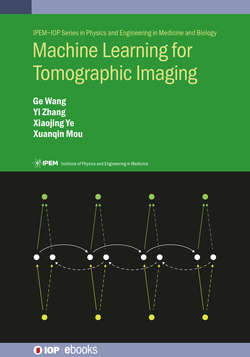Читать книгу Machine Learning for Tomographic Imaging - Professor Ge Wang - Страница 8
На сайте Литреса книга снята с продажи.
Preface
ОглавлениеThis book arose from discussions among four colleagues with a long-standing collaboration and interest in advanced medical image reconstruction methods and applications. Beginning in 2018, our group realized the gap in the literature and in particular among technical books on the emerging technologies that develop and apply artificial intelligence/machine learning (AI/ML) techniques to tomographic reconstruction or tomographic imaging.
As early as 2012, we recognized the opportunity presented by machine learning in formulating plans for doctoral dissertation research where dictionary learning can be used to recover images from projection measurements. By connecting several contemporary image recovery and signal processing methods, in particular compressed sensing, neural network, and deep learning techniques, our discussions and projects converge to develop and apply ML methods to advance the frontier of image reconstruction, with an emphasis on medical imaging.
The interested reader entering this field may have a background in artificial intelligence or mathematical knowledge of tomographic reconstruction, but few will have all of the knowledge needed to understand the field of ML for tomographic image reconstruction. Hence, we have now created this book to cover what we believe to be a comprehensive collection of key topics in a logical and consistent manner.
The prerequisites for reading this book include calculus, matrix algebra, Fourier analysis, medical physics, and basic programming skills. We believe that PhD candidates in the imaging field are generally well prepared to understand all of the content through serious effort, while advanced undergraduate students can also learn essential ideas and capture selected materials (you can skip the chapters/sections/subsections marked with an ‘*’). To facilitate teaching and learning, most relevant numerical methods are described in appendix A, and hands-on projects are suggested in appendix B, with sample codes and working datasets.
The logical dependence between the key components of this book is illustrated in the diagram in the introduction below. We strongly recommend that you read this introduction first to obtain an overall perspective. It is also recommended to read the first three chapters sequentially so that you are well prepared with both the imaging context and network basics. However, chapter 3 alone is a good introduction to general knowledge on artificial neural networks. Then, we can proceed in parallel to CT, MRI, or other tomographic modalities, which are covered in parts II, III, and IV of the book, respectively. It would be the best to read part IV after reading parts II and III as deep reconstruction networks are clearly explained for CT and MRI in these two parts. Appendix A can be read as needed, but appendix B is strongly recommended, and should be at least consulted to run the basic networks explained in chapter 3. The network examples for CT and MRI can be adapted for independent class projects.
We hope that this book will be useful for a review course at the graduate level, but it has not been tested yet. As teaching experience is accumulated using this book, homework problems and solutions will become available, along with example class project reports and codes. A book-related website is maintained on the Fully3D community website: http://www.fully3d.org/rpi/.
The materials contained in this book are presented in their first version. As a result, a number of topics are not treated in detail or in depth. Nevertheless, after reading this book you should have state-of-the-art knowledge of a broad spectrum of methods. We welcome your critiques and suggestions so we can make future versions better, with key references cited in a more balanced way.
July 2019
